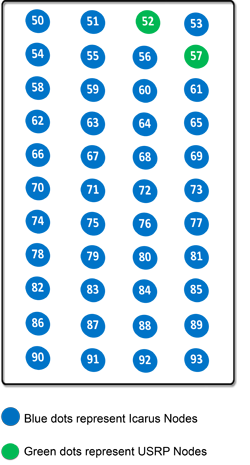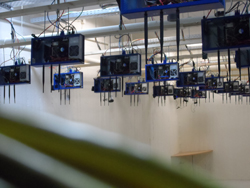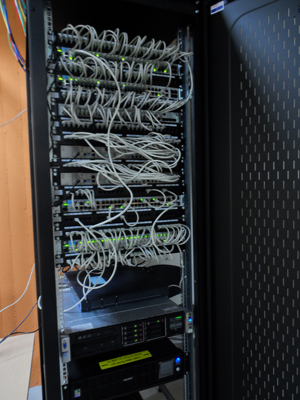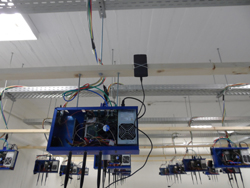Tholos Indoor Testbed
The NITOS indoor testbed consists of 40 Icarus nodes and is deployed in an isolated environment at the University of Thessaly's campus building. Each Icarus node consists of multiple heterogeneous interfaces giving the user/ experimenter the ability to design and implement a wide range of realistic scenarios. A more detail review of the ICARUS node could be found here.
NITOS Topology
 |
Icarus nodes are placed in a symmetrical way around the isolated environment of NITOS testbed forming a Grid architecture. The distance amongst the nodes is fixed to 1.2 meters and the height level is identical for all them as well. As a result, a uniform environment is created where all nodes are isobaric and of equal capabilities.  Figure 1. NITOS Grid View |
Deployment
|
 Figure 2. Rack View |
Hardware Extensions
NITOS indoor testbed features a software defined radio (SDR) testbed that consists of 2 Universal Software Radio Peripheral (USRP) devices attached to the NITOS ICARUS nodes. USRPs allow the researcher to program a number of physical layer features (e.g. modulation), thereby enabling dedicated PHY layer or cross-layer research.
In advance, five smart handheld devices, i.e. Google Nexus Smartphones hosting Android OS, are mounted on equal number of nodes thus enabling experimentation over mobile technologies, i.e. Bluetooth, A/V Streaming, LTE, WiFi, etc. The availability of multiple and heterogeneous devices, in the concept of technology and interfaces provisioning, sustain NITOS as a cross platform testbed; thus allowing the research community to design and implement highly advanced scenarios on top of state of the art equipment.
 Figure 3. Mobile Devices |
 Figure 4. USRP Devices |
Tholos Indoor Testbed Live Feed
As a result, a uniform environment is created where all nodes are isobaric and of equal capabilities.
Who's Online
We have 3 guests and no members online


